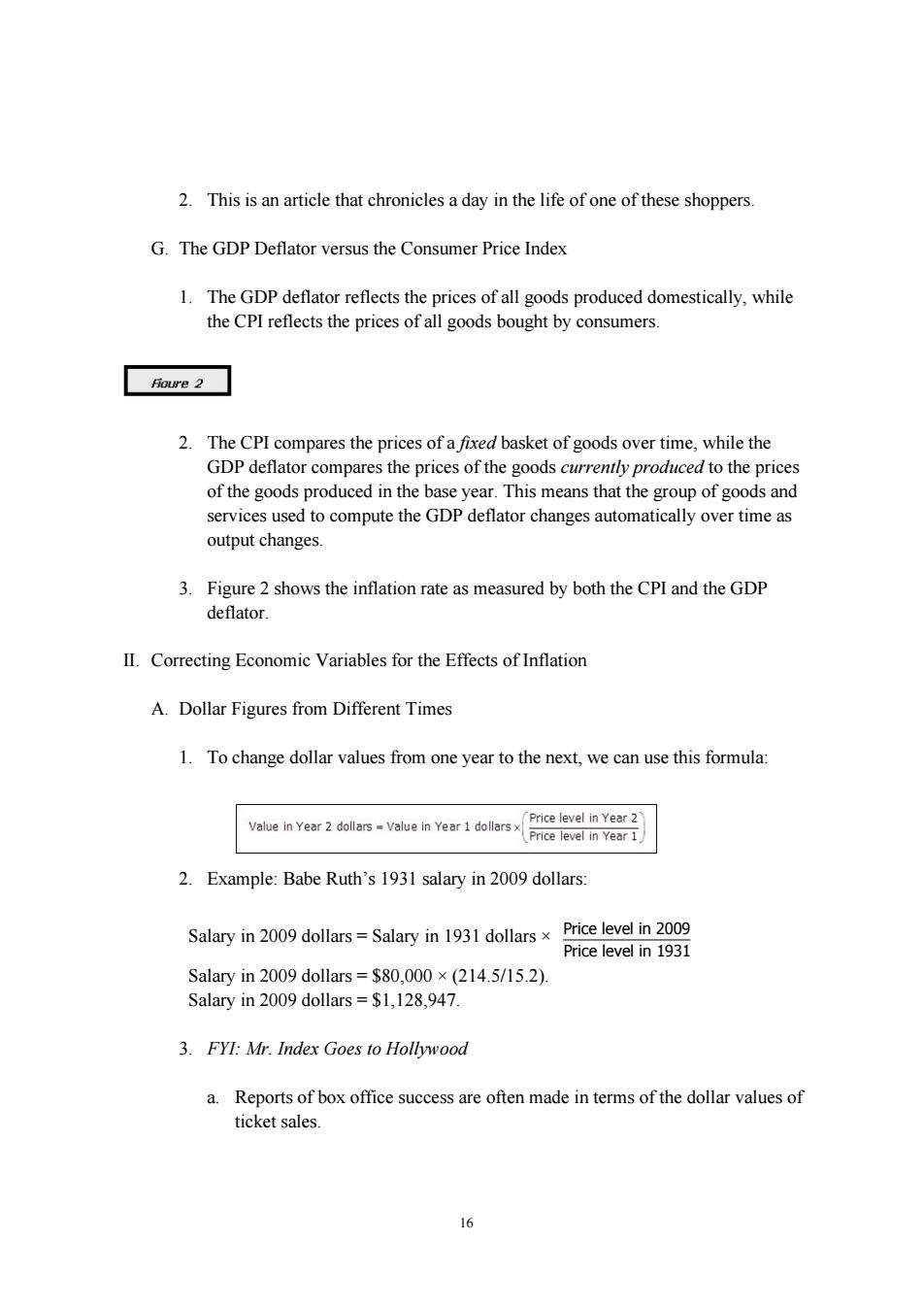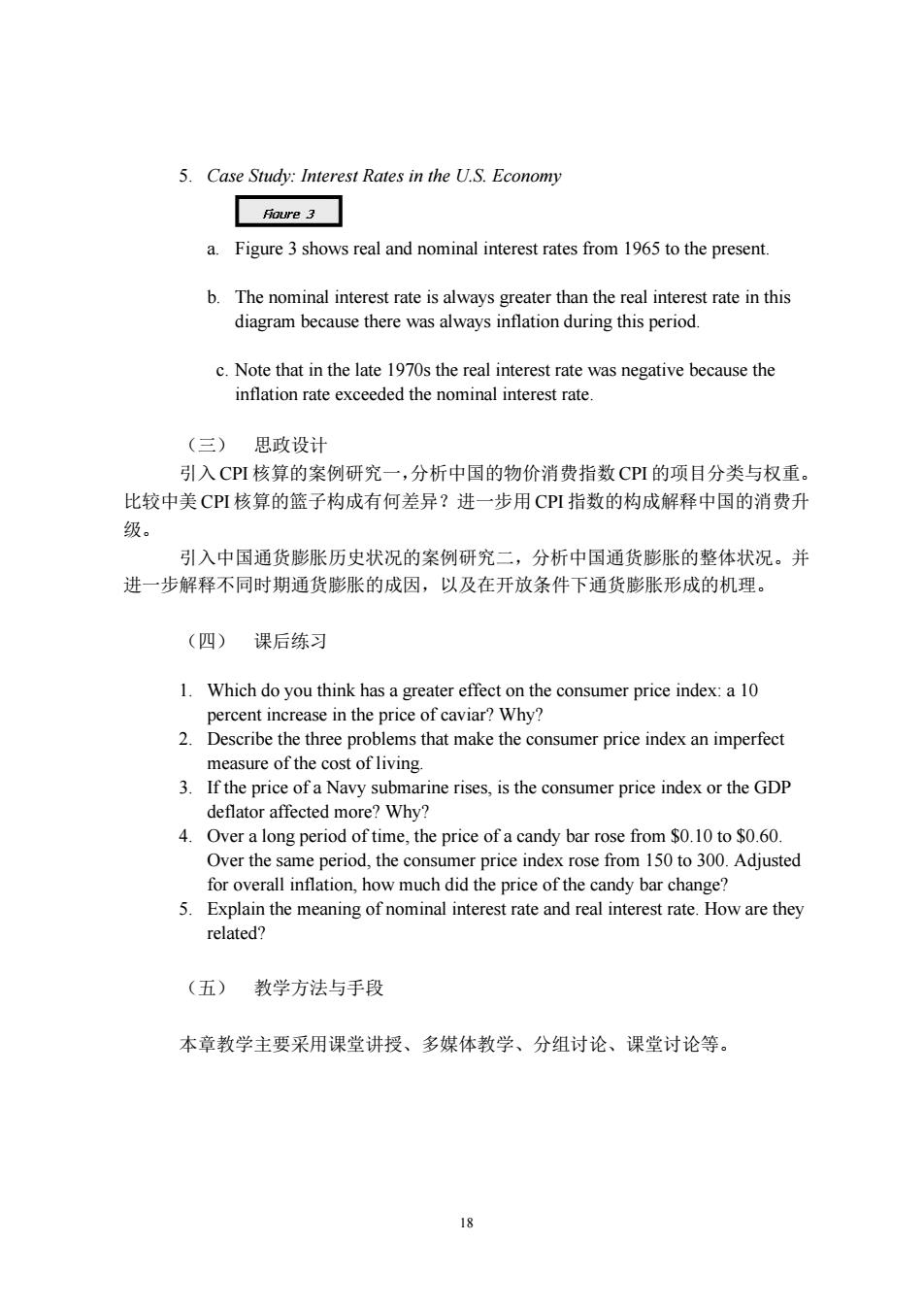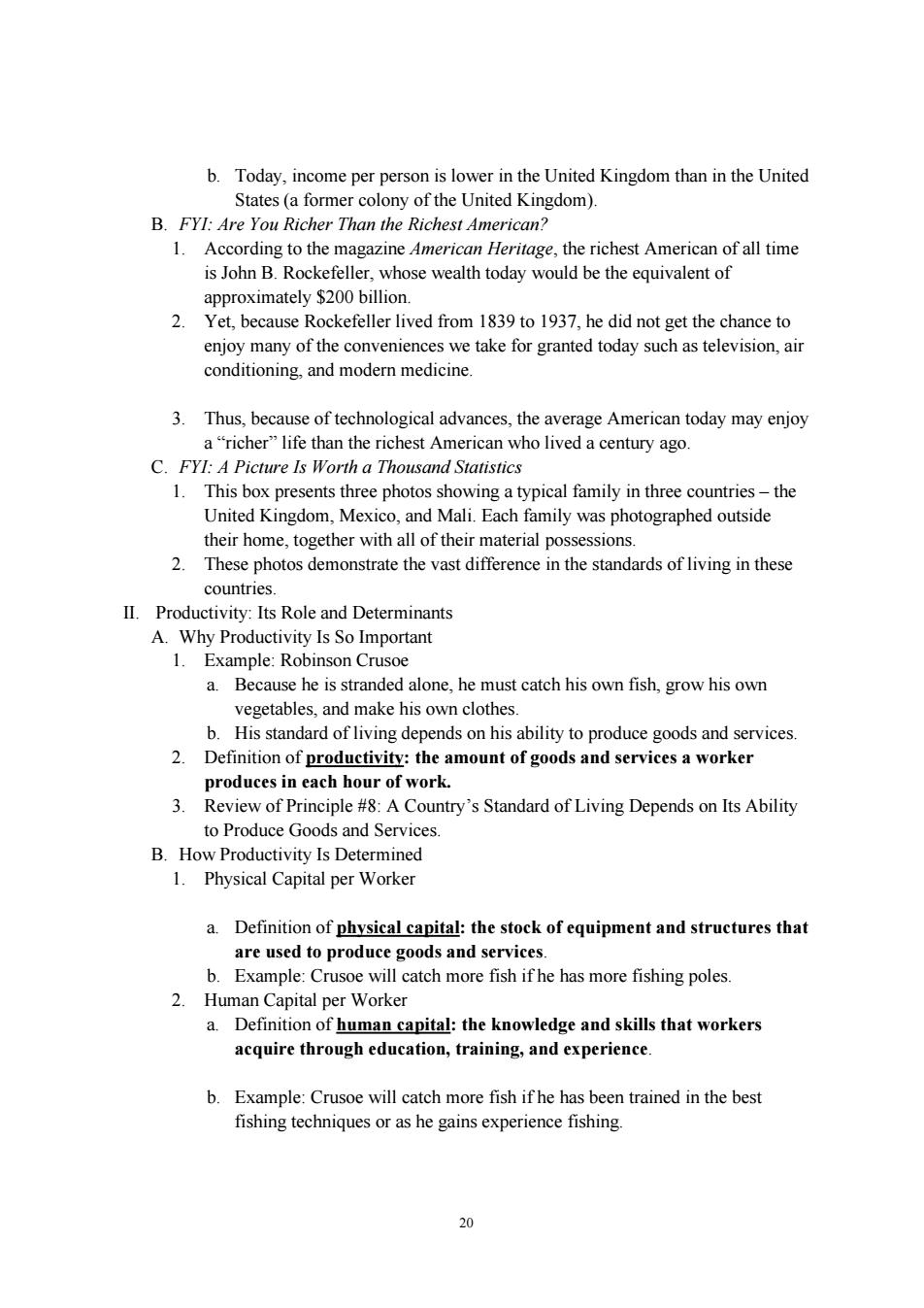
2.This is an article that chronicles a day in the life of one of these shoppers. G.The GDP Deflator versus the Consumer Price Index 1.The GDP deflator reflects the prices of all goods produced domestically,while the CPI reflects the prices of all goods bought by consumers. 2.The CPI compares the prices of a fixed basket of goods over time,while the GDP deflator compares the prices of the goods currently produced to the prices of the goods produced in the base year.This means that the group of goods and used tocompute eflator changes automatically over time as output changes. 3.Figure 2 shows the inflation rate as measured by both the CPI and the GDP deflator II.Correcting Economic Variables for the Effects of Inflatior A.Dollar Figures from Different Times 1.To change dollar values from one year to the next,we can use this formula 2.Example:Babe Ruth's 1931 salary in 2009 dollars Salary in2009 dollars=$80,000×(214.5/15.2). Salary in 2009 dollars $1.128.947. 3.FYI:Mr.Index Goes to Hollywood a.Reports of box office success are often made in terms of the dollar values of ticket sales. 16
16 2. This is an article that chronicles a day in the life of one of these shoppers. G. The GDP Deflator versus the Consumer Price Index 1. The GDP deflator reflects the prices of all goods produced domestically, while the CPI reflects the prices of all goods bought by consumers. 2. The CPI compares the prices of a fixed basket of goods over time, while the GDP deflator compares the prices of the goods currently produced to the prices of the goods produced in the base year. This means that the group of goods and services used to compute the GDP deflator changes automatically over time as output changes. 3. Figure 2 shows the inflation rate as measured by both the CPI and the GDP deflator. II. Correcting Economic Variables for the Effects of Inflation A. Dollar Figures from Different Times 1. To change dollar values from one year to the next, we can use this formula: 2. Example: Babe Ruth’s 1931 salary in 2009 dollars: Salary in 2009 dollars = Salary in 1931 dollars × Price level in 2009 Price level in 1931 Salary in 2009 dollars = $80,000 × (214.5/15.2). Salary in 2009 dollars = $1,128,947. 3. FYI: Mr. Index Goes to Hollywood a. Reports of box office success are often made in terms of the dollar values of ticket sales

b.These ticket sales are then compared with ticket sales of movies in the past. c.However,no correction for changes in the value of a dollar are made. B.Indexation 1.Definition of indexation:the automatic correction of a dollar amount for the effects of inflation by law or contract. 2. As mentioned above,many government transfer programs use indexation for the benefits.The government also indexes the tax brackets used for federal income tax. 3.There include cost-of-living allowances(COLAs). C.Real and Nominal Interest Rates 1.Example:Sally Saver into a bank account that pays an annual interest rate of1% A year later,she withdraws$1,100. 2.What matters to Sally is the purchasing power of her money a.If there is zero inflation,her purchasing power has risen by10%. b.If there is6%inflation,her purchasing power has risen by about 4% c.If there is 10%inflation,her purchasing power has remained the same. d.If there is 12%inflation,her purchasing power has declined by about2% e.If there is2%deflation,her purchasing power has risen by about 12% 3.Definition of nominal interest rate:the interest rate as usually reported without a correction for the effects of inflation. 4.Definition of realinterest rate:the interest rate corrected for the effects of inflation. real interest rate=nominal interest rate-inflation rate 17
17 b. These ticket sales are then compared with ticket sales of movies in the past. c. However, no correction for changes in the value of a dollar are made. B. Indexation 1. Definition of indexation: the automatic correction of a dollar amount for the effects of inflation by law or contract. 2. As mentioned above, many government transfer programs use indexation for the benefits. The government also indexes the tax brackets used for federal income tax. 3. There are uses of indexation in the private sector as well. Many labor contracts include cost-of-living allowances (COLAs). C. Real and Nominal Interest Rates 1. Example: Sally Saver deposits $1,000 into a bank account that pays an annual interest rate of 10%. A year later, she withdraws $1,100. 2. What matters to Sally is the purchasing power of her money. a. If there is zero inflation, her purchasing power has risen by 10%. b. If there is 6% inflation, her purchasing power has risen by about 4%. c. If there is 10% inflation, her purchasing power has remained the same. d. If there is 12% inflation, her purchasing power has declined by about 2%. e. If there is 2% deflation, her purchasing power has risen by about 12%. 3. Definition of nominal interest rate: the interest rate as usually reported without a correction for the effects of inflation. 4. Definition of real interest rate: the interest rate corrected for the effects of inflation

5.Case Study:Interest Rates in the U.S.Economy foure 3 a.Figure 3 shows real and nominal interest rates from 1965 to the present b.The nominal interest rate is always greater than the real interest rate in this diagram because there was always inflation during this period. c.Note that in the late 1970s the real interest rate was negative because the inflation rate exceeded the nominal interest rate (三)思政设计 引入CPI核算的案例研究一,分析中国的物价消费指数CPI的项目分类与权重。 比较中美CPI核算的篮子构成有何差异?进一步用CPI指数的构成解释中国的消费升 级。 引入中国通货膨胀历史状况的案例研究二,分析中国通货膨胀的整体状况。并 进一步解释不同时期通货膨胀的成因,以及在开放条件下通货膨胀形成的机理。 (四)课后练习 1.Which do you think hasagreater fc the consmer price index:a 10 ease in the price caviar?Why? seribethe thres problems that make the consumer price indes an imperfeet 2. measure of the cost of living. 3.If the price of a Navy submarine rises,is the consumer price index or the GDP deflator affected more?Why? 4.Over a long period oftime,the price of a candy bar rose from$0..60. Over the ame period,the consumer price index rose.Adjusted for overall inflation,how much did the price of the candy bar change? 5.Explain the meaning of nominal interest rate and real interest rate.How are they related? (五)教学方法与手段 本章教学主要采用课堂讲授、多媒体教学、分组讨论、课堂讨论等。 18
18 5. Case Study: Interest Rates in the U.S. Economy a. Figure 3 shows real and nominal interest rates from 1965 to the present. b. The nominal interest rate is always greater than the real interest rate in this diagram because there was always inflation during this period. c. Note that in the late 1970s the real interest rate was negative because the inflation rate exceeded the nominal interest rate. (三) 思政设计 引入 CPI 核算的案例研究一,分析中国的物价消费指数 CPI 的项目分类与权重。 比较中美 CPI 核算的篮子构成有何差异?进一步用 CPI 指数的构成解释中国的消费升 级。 引入中国通货膨胀历史状况的案例研究二,分析中国通货膨胀的整体状况。并 进一步解释不同时期通货膨胀的成因,以及在开放条件下通货膨胀形成的机理。 (四) 课后练习 1. Which do you think has a greater effect on the consumer price index: a 10 percent increase in the price of caviar? Why? 2. Describe the three problems that make the consumer price index an imperfect measure of the cost of living. 3. If the price of a Navy submarine rises, is the consumer price index or the GDP deflator affected more? Why? 4. Over a long period of time, the price of a candy bar rose from $0.10 to $0.60. Over the same period, the consumer price index rose from 150 to 300. Adjusted for overall inflation, how much did the price of the candy bar change? 5. Explain the meaning of nominal interest rate and real interest rate. How are they related? (五) 教学方法与手段 本章教学主要采用课堂讲授、多媒体教学、分组讨论、课堂讨论等

第二十五章Production and Growth (一)目的与要求 Chapter 25 is the first chapter in a four-chapter sequence on the production of output in the long run.Chapter 25 addresses the determinants of the level and growth rate of output.We find that capital and labor are among the primary determinants of output.In Chapter 26,we address how saving and investm in apital goods affect the production of output,and in Chapter 27,we learn about some of the tools people and fi ns use wher choosing capital projects in which to invest.In Chapter 28,we address the market for labor. The purpose of Chapter 25 is to examine the long-run determinants of both the level and the growth rate of real GDP per person.Along the way,we will discover the factors that productivity of orkers and address what might do toimprove the productivity of their citizens In this chapter.students should: 1.see how much economic growth differs around the world codvy is th ky detennt odd of living 3.analyze the determine a country's productivity 4.examine how a country's policies influence its productivity growth (二)教学内容 l Economic Growth Around the world A.Table 1 shows data on real GDP per person for 13 countries during different periods of time. 1.The data reveal the fact that living standards vary a great deal between these ountries 2.Growth rates are also reported in the table.Japan has had the largest growth rate over time,2.76%per year (on average). 3.Because of different growth rates,the ranking of countries by income per person changes over time. a.In the late 19th century,the United Kingdom was the richest country in the world. 19
19 第二十五章 Production and Growth (一) 目的与要求 Chapter 25 is the first chapter in a four-chapter sequence on the production of output in the long run. Chapter 25 addresses the determinants of the level and growth rate of output. We find that capital and labor are among the primary determinants of output. In Chapter 26, we address how saving and investment in capital goods affect the production of output, and in Chapter 27, we learn about some of the tools people and firms use when choosing capital projects in which to invest. In Chapter 28, we address the market for labor. The purpose of Chapter 25 is to examine the long-run determinants of both the level and the growth rate of real GDP per person. Along the way, we will discover the factors that determine the productivity of workers and address what governments might do to improve the productivity of their citizens. In this chapter, students should: 1. see how much economic growth differs around the world 2. consider why productivity is the key determinant of a country’s standard of living 3. analyze the factors that determine a country’s productivity 4. examine how a country’s policies influence its productivity growth (二) 教学内容 I. Economic Growth Around the World A. Table 1 shows data on real GDP per person for 13 countries during different periods of time. 1. The data reveal the fact that living standards vary a great deal between these countries. 2. Growth rates are also reported in the table. Japan has had the largest growth rate over time, 2.76% per year (on average). 3. Because of different growth rates, the ranking of countries by income per person changes over time. a. In the late 19th century, the United Kingdom was the richest country in the world

b.Today,income per person is lower in the United Kingdom than in the United States(a former colony of the United Kingdom). B.FYI:Are You Richer Than the Richest American? Accordin to the ma gazine American Her e,the richest American of all time is John B】 wealth today would be approximately $200 billion. 2 Yet because rockefeller lived from 1839 to 1937 he did not get the chance to enioy many of the conveniences we take for granted today such as television.air conditioning.and modern medicine. 3.Thus,because of technological advances,the average American today may enjoy a"richer"life than the richest American who lived a century ago. C.FYI:A Picture Is Worth a Thousand Statistics 1.This bx showing typical faily in three United Kingdom,Mexi o, and Mali.Eac amily was photographed outside their home,together with all of their material possessions 2 These photos demonstrate the vast difference in the standards of living in these countries. Il Productivity Its Role and Determinants A.Why Productiv mportant inson Cruse a.Because he is stranded alone,he must catch his own fish,grow his own vegetables.and make his own clothes. b.His standard of living depends on his ability to produce goods and services. 2.Definition of productivity:the amount of goods and services a worker produces in each hou of work. 3. Review of Principle#8 A Country's Standard of Living Depends on Its Ability to Produce Goods and Services. B.How Productivity Is Determined 1.Physical Capital per Worker a Definition of physical capital:the stock of equipment and structures that are used to produce goods and services b.Example:Crusoe will catch more fish if he has more fishing poles. 2.Human Capital per Worker acquire through education,training,and experience b.Example:Crusoe will catch more fish if he has been trained in the best fishing techniques or as he gains experience fishing. 20
20 b. Today, income per person is lower in the United Kingdom than in the United States (a former colony of the United Kingdom). B. FYI: Are You Richer Than the Richest American? 1. According to the magazine American Heritage, the richest American of all time is John B. Rockefeller, whose wealth today would be the equivalent of approximately $200 billion. 2. Yet, because Rockefeller lived from 1839 to 1937, he did not get the chance to enjoy many of the conveniences we take for granted today such as television, air conditioning, and modern medicine. 3. Thus, because of technological advances, the average American today may enjoy a “richer” life than the richest American who lived a century ago. C. FYI: A Picture Is Worth a Thousand Statistics 1. This box presents three photos showing a typical family in three countries – the United Kingdom, Mexico, and Mali. Each family was photographed outside their home, together with all of their material possessions. 2. These photos demonstrate the vast difference in the standards of living in these countries. II. Productivity: Its Role and Determinants A. Why Productivity Is So Important 1. Example: Robinson Crusoe a. Because he is stranded alone, he must catch his own fish, grow his own vegetables, and make his own clothes. b. His standard of living depends on his ability to produce goods and services. 2. Definition of productivity: the amount of goods and services a worker produces in each hour of work. 3. Review of Principle #8: A Country’s Standard of Living Depends on Its Ability to Produce Goods and Services. B. How Productivity Is Determined 1. Physical Capital per Worker a. Definition of physical capital: the stock of equipment and structures that are used to produce goods and services. b. Example: Crusoe will catch more fish if he has more fishing poles. 2. Human Capital per Worker a. Definition of human capital: the knowledge and skills that workers acquire through education, training, and experience. b. Example: Crusoe will catch more fish if he has been trained in the best fishing techniques or as he gains experience fishing